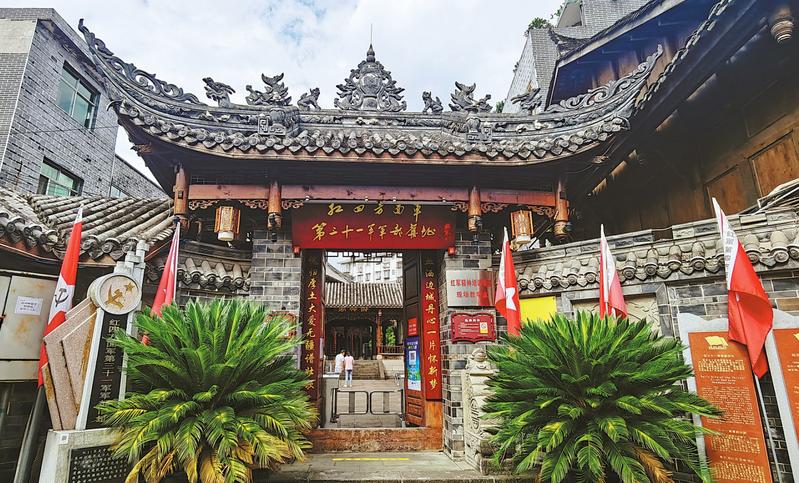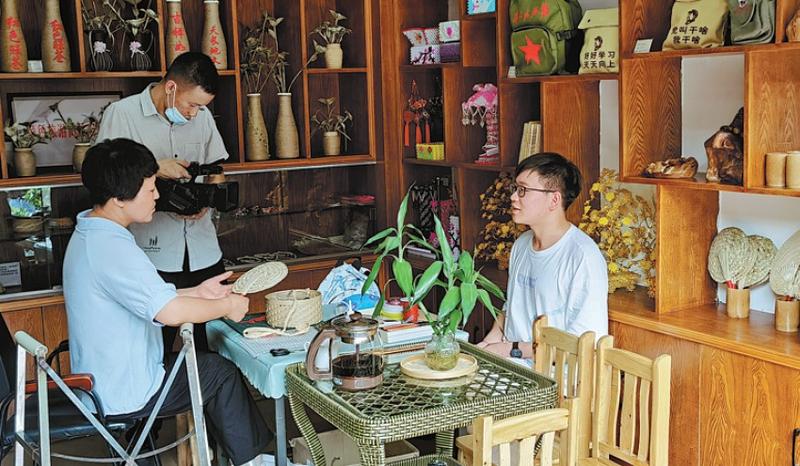From the Red Army and an empress to mountain passes and precipitous planked roads, Guangyuan has a wealth of cultural tourism, Huang Zhiling reports.
 The former headquarters of the 31st Army of the Fourth Front Army in Wangcang county, Guangyuan, Sichuan province. (HUANG LERAN / FOR CHINA DAILY)
The former headquarters of the 31st Army of the Fourth Front Army in Wangcang county, Guangyuan, Sichuan province. (HUANG LERAN / FOR CHINA DAILY)
Although Mumen is remote and mountainous, the small town in Wangcang county, Sichuan province, receives some 300,000 visitors each year.
People come specifically to visit the Memorial Site of the Mumen Meeting, where many slogans engraved on stones in the 1930s by the Fourth Front Army of the Red Army are on display, according to Shi Xiaofang, a young female guide.
When I walked on the plank road, built into the dangerous cliffs above the gushing Jialing River, I had an awesome respect for those who built it
Wu Dan, tourist from Beijing
During its more than two-year stay in Wangcang, now a county in Guangyuan, the Fourth Front Army left behind many stones engraved with slogans interpreting policies of the Communist Party of China.
In late June 1933, over 100 officers of the Fourth Front Army convened a six-day meeting in a Buddhist temple in Mumen, summarizing the experience of winning the fight against the encirclement and suppression by the Kuomintang army and making the decision to expand the Fourth Front Army.
The army had built the second largest revolutionary base of the Soviet Republic of China in the border areas of Sichuan and neighboring Shaanxi province in the early 1930s.
In 1931, the provisional central government of the Soviet Republic of China was established in Ruijin in Jiangxi province, and the central revolutionary area was the largest of its kind.
About 38 kilometers away from the Memorial Site of the Mumen Meeting is the county town of Wangcang, where the 1.5-square-kilometer China Red Army Town is located.
 The Cliff of 1,000 Buddhas, or Qianfoya, an important ancient cultural relic site along the Shu Path. Its construction started during the Southern and Northern Dynasties (420-581). (HUANG LERAN / FOR CHINA DAILY)
The Cliff of 1,000 Buddhas, or Qianfoya, an important ancient cultural relic site along the Shu Path. Its construction started during the Southern and Northern Dynasties (420-581). (HUANG LERAN / FOR CHINA DAILY)
Consisting of two streets and two lanes, the town, constructed in the style of the Qing Dynasty (1644-1911) and early 20th century, is one of the largest and best preserved Red Army memorial sites in the country.
With a population of 120,000, a total of 12,000 people from Wangcang joined the Red Army, 3,000 of which were women, Shi says.
The building which housed the Sichuan-Shaanxi Soviet Government, and the headquarters of the Fourth Front Army, are in the China Red Army Town.
In addition to the Red Army, Guangyuan is known as the birthplace of Wu Zetian (624-705), China's only ruling empress.
Wu was the fourth ruler of the Tang Dynasty (618-907). During her reign, from 683 to 705, Wu excelled at appointing capable people and China enjoyed peace and prosperity.
The Huangze (meaning "Imperial Bounties" in Chinese) Temple on the bank of the Jialing River and at the foot of the Wulong Hill in Guangyuan is dedicated to the empress.
There, a 1.8-meter high stone statue of the empress sitting in a gilded dress is the only statue in China modeled on her true appearance, says Du Juan, a guide at the temple.
 An intangible cultural heritage inheritor introduces products made from palm leaves in the China Red Army Town in Wangcang. (HUANG LERAN / FOR CHINA DAILY)
An intangible cultural heritage inheritor introduces products made from palm leaves in the China Red Army Town in Wangcang. (HUANG LERAN / FOR CHINA DAILY)
In ancient times, women were considered inferior to men and were confined to doing housework around the home.
Wu permitted women to take imperial examinations and assigned government posts to those who passed.
Women in Guangyuan were proud of their empress. Every year on her birthday, which fell during the first month of the Chinese lunar calendar, they would visit the Huangze Temple, burning incense and paying homage.
Local women took the day off and their husbands had to take care of all the household chores.
After paying homage to Wu, the women would visit a temple fair, row boats in the Jialing River and have picnics on the hill.
Over time, the activities have evolved into a festival in Wu's honor, and is today known as Guangyuan Women's Day, which falls on Sept 1 each year, according to Huang Lixia, an official with the Guangyuan government information office.
Guangyuan has abundant tourist attractions, many of which precede even the empress.
 The site of an ancient county government in Zhaohua Ancient Town in Guangyuan, Sichuan province. (HUANG LERAN / FOR CHINA DAILY)
The site of an ancient county government in Zhaohua Ancient Town in Guangyuan, Sichuan province. (HUANG LERAN / FOR CHINA DAILY)
The best-known site is the Sword Gate Pass, a towering V-shaped mountain pass on the Shu Path, which gave rise to the household Chinese idiom: "One man at the pass keeps 10,000 men at bay". Shu is the ancient name for Sichuan.
As the pass was the only passageway to North China, almost every ambitious ruler who wanted to conquer Sichuan had to first take the pass. Since 316 BC, some 100 battles have been fought there. Because the pass is so steep, not a single frontal attack has been successful.
Another grand sight on the Shu Path is the Cuiyun Corridor, a 150-kilometer-long, stone-paved, cypress-shaded post road.
In ancient times, important letters of state were carried by horseback couriers along the thoroughfare.
As snow often covered the road in winter and the summer sun gave the couriers a scorching ride, local officials ordered cypresses to be planted on both sides of the road, to provide shelter and shade all year round.
The planting, which began in the Qin Dynasty (221-206 BC), lasted until the Ming Dynasty (1368-1644). By then, in excess of 100,000 cypresses had been planted-more than 8,000 of which survive to this day.
 An old house in Zhaohua Ancient Town, which has been converted into an inn. (HUANG LERAN / FOR CHINA DAILY)
An old house in Zhaohua Ancient Town, which has been converted into an inn. (HUANG LERAN / FOR CHINA DAILY)
Guangyuan is also known for a plank road built along the Shu Path. Construction of the Shu Path, linking Sichuan and neighboring Shaanxi province, started around 316 BC. It was built on mountains so precipitous that Li Bai (701-762), a great Chinese poet, wrote, "Traveling on the Shu Path is as difficult as ascending to heaven."
When the builders of the path approached the Mingyue Gorge in what is the present-day Chaotian district of Guangyuan, they found it impossible to continue, as the cliffs were too steep. After much thought, they came up with a bold idea.
They chiseled holes at three different heights into the cliffs and inserted wooden beams into them. The upper beams were covered with planks to form a road for pedestrians and the second and third, lower holes, held buttresses.
During the Three Kingdoms period (220-280), Zhuge Liang, prime minister of the Shu Kingdom, used the plank road to transport troops to fight against the Wei Kingdom of North China.
The plank road was burned down and rebuilt many times during various wars. Now, part of it has been restored to allow visitors to admire this man-made wonder.
"When I walked on the plank road, built into the dangerous cliffs above the gushing Jialing River, I had an awesome respect for those who built it," says Wu Dan, a female tourist from Beijing.
 The wall and tower of Jiameng Pass in Zhaohua Ancient Town, which was built during the Ming Dynasty (1368-1644). (HUANG LERAN / FOR CHINA DAILY)
The wall and tower of Jiameng Pass in Zhaohua Ancient Town, which was built during the Ming Dynasty (1368-1644). (HUANG LERAN / FOR CHINA DAILY)
Also on the Shu Path is the Jueyuan Temple, which was built in 816 during the Tang Dynasty. The temple holds China's best-preserved and most complete Buddhist murals.
Covering 174 square meters, the Ming Dynasty murals tell 209 stories about Sakyamuni, the founder of Buddhism, starting with his reincarnation and ending with the distribution of his Buddhist relics by his disciples.
The murals are painted in the style of Wu Daozi, a famous Tang Dynasty painter known for his figure paintings, says Wang Xianjun, a guide at the temple.
Written during the Ming Dynasty, the classic novel Romance of the Three Kingdoms has stories which take place in Guangyuan.
Many readers are captivated by the duel between Zhang Fei and Ma Chao, two of the greatest generals of their time, which takes place in front of the Jiameng Pass in Chapter 65 of the novel.
The pass is located in the Zhaohua Ancient Town in the Zhaohua district of Guangyuan.
It is one of the best-preserved ancient towns in China, with a number of well maintained buildings that take visitors back to imperial times, including the local magistrate's building, the site of an ancient local government. In the middle of the town there is an imperial examination hall.
Guangyuan has easy transportation facilities with direct flights to Guangyuan Airport from many major cities, such as Beijing, Shanghai and Shenzhen, as well as high speed train links to major conurbations around the country.
Contact the writer at huangzhiling@chinadaily.com.cn


